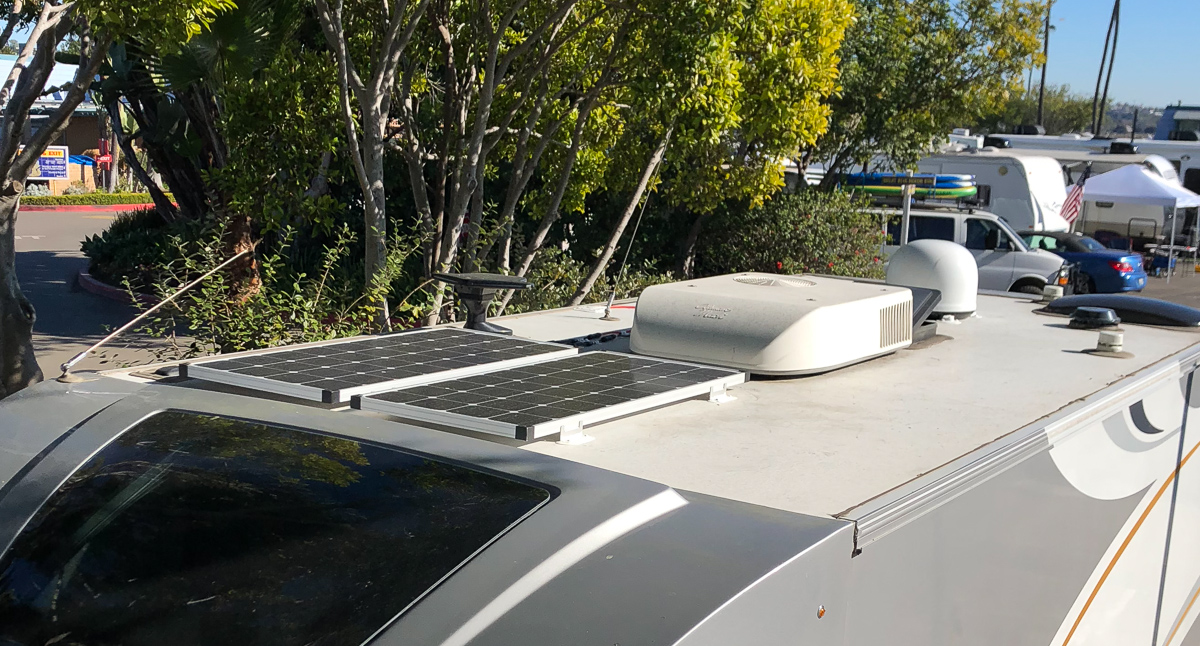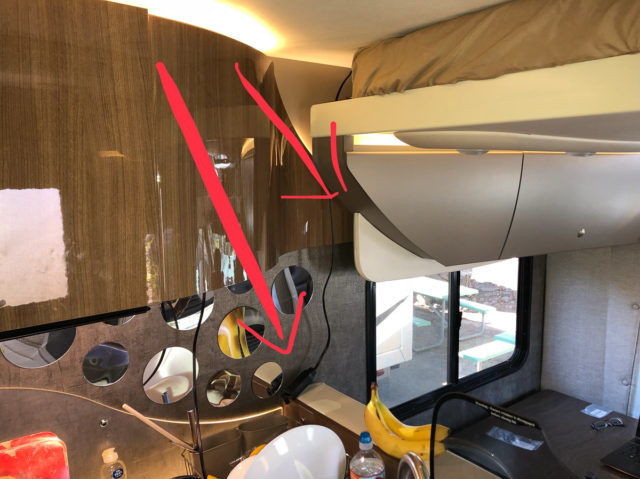This setup was a total of about $650 in parts.
My 2 panels on the roof are each 100 watt. I bought a 2-Pack of these panels for about $206:
https://amzn.to/2BKAh7E
And the mounting hardware for the panels :
It easy fits 3 panels next to each other and even a 4th one next to the A/C if desired.

I placed the inverter under the fridge, mounted on the wheel case.

With the air vent mounted upside down I can see the display, voltage, watt connected and the solar charge status:

The inverter has a build in solar charge controller for up to 300 watt, means it can support 3 of the solar panels I used.
I got this Inverter because it has a build in Solar Charge controller and saved me wiring, you can go directly from the solar panels to your Inverter. Also, the Inverter has been complete silent, seams the fans only come on at high loads and I could never hear any noise coming from it, which I like. I tried other models prior this one and they had annoying fan noise. I paid around $300 for the Inverter:

Other parts I used for my Solar/Inverter install:
For the 12 volt cable from the batteries to the Inverter I bought a cheap 25 feet starter cable with Gauge 4 wire for about $16 and I cut off booth ends and cut it to length. I think I ended using about 10 feet from batteries to under fridge.
And 2 of those – go in line (plugged) with each solar panel:
One pair of these to combine the 2 panels, plugged:
One wire for going from the roof,
into the RV above the microwave, used the same, drilled hole as I used for my Sat-Dish. Next, fishing down the wires in the left front corner of the fridge cabinet, the tunnel where the 3 light switches are. (my RV is a 23L) I used the same tunnel to run two 110 Volt 10 feet extension cords – both plugged into the front of the inverter – one toward the TV and one toward the cabinet with the sat receiver. The extension cords I used have each three 3-pin-110V-outlets and from that I can run, with an additional cord, my laptop, toaster, egg-cooker, coffee maker, hair dryer, and other 110V items unter 1300 Watt.
The inverter came with a remote on/off-switch and I run its wire also in the same tunnel with the other wires, toward the cabinet with the sat-cable-outlet-panel:

To get 110V at the kitchen and dinette:
In my case, the 23L model, it does not bother me to run a small 12 feet extension cord from behind the TV two feed under the ceiling toward the upper bed, stick it across the RV between mattress and ceiling, coming down in the kitchen, at the wall where dinette and kitchen meets. From here I can connect easy my laptop and the small kitchen items. Running this cord takes me each time less than 30 seconds and it’s not in the way or much visible.


Additional thoughts:
I tested this setup and it runs okay for up to 1300 Watts / hair dryer (few minutes, drops inverter input voltage to 9.7 volt) or 800 Watts (my toaster plus egg-cooker together, drops inverter input voltage to 11.0 volt). The 10 feet long gauge 4 cable does cause some Voltage drop between Battery and Inverter (I measured under load). I am sure a higher gauge cable could run you a higher wattage at the Inverter but I don’t intent doing that in order to keep the batteries safe. Still, a better install could be using Gauge zero rates cables:
(PS: lower gauge numbers are a higher diameter of the cable, less resistance)
I would NOT go higher than my 2200 Watt inverter install as the original batteries, even they are two parallel batteries, don’t handle that much amp for a number of minutes. I measured my microwave wattage with a watt meter and even it’s only a 1100 watt microwave it draws measured 1600 watt. 1600/12volt = 133 amp – but the real amp needs to be even higher because such a high draw causes the voltage to drop to around 9 volt at the batteries, because you start matching the internal resistance of your batteries. (I measured it while the microwave tried to run but it caused the inverter in seconds to protect the batteries and shuts down for security)
